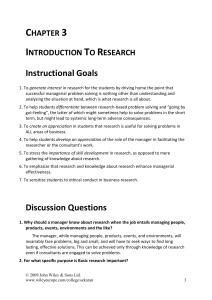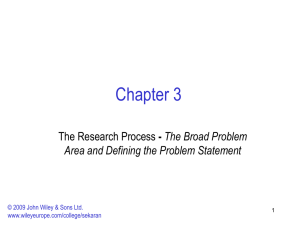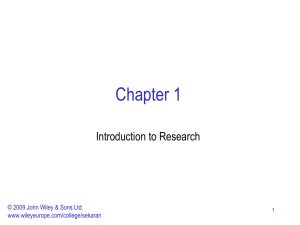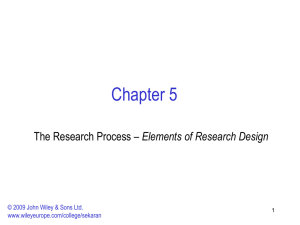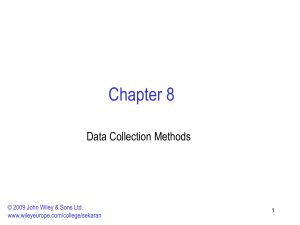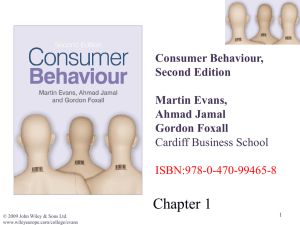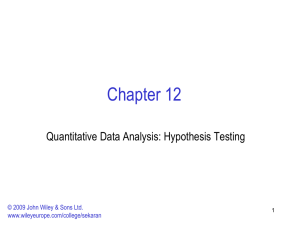CH09
advertisement
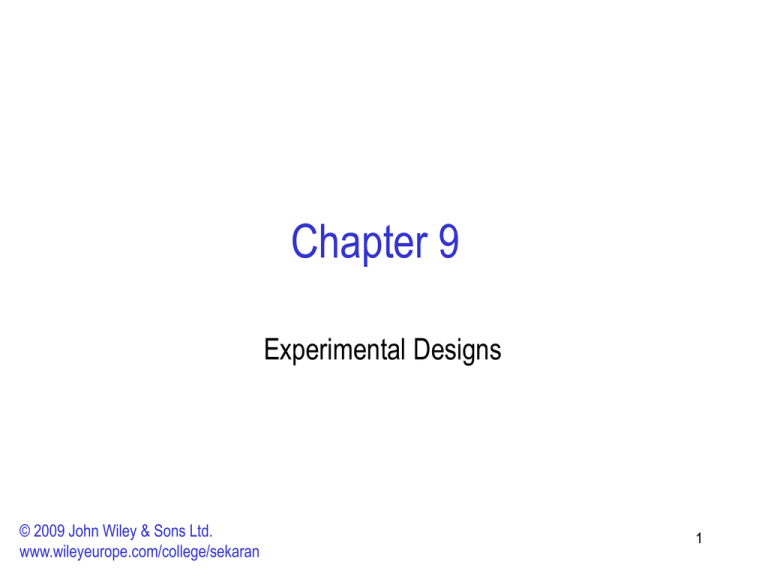
Chapter 9 Experimental Designs © 2009 John Wiley & Sons Ltd. www.wileyeurope.com/college/sekaran 1 Causal Research Research conducted to identify cause-and-effect relationships among variables when the research has already been narrowly defined © 2009 John Wiley & Sons Ltd. www.wileyeurope.com/college/sekaran 2 Evidence for Causality Covariation Time order of occurrence of variable Elimination of other possible causal factors A logical explanation – Evidence of the extent to which X and Y occur together or vary together in the way predicted by the hypothesis – Evidence that shows X occurs before Y – Evidence that allows the elimination of factors other than X as the cause of Y – About why the independent variable affects the dependent variable. © 2009 John Wiley & Sons Ltd. www.wileyeurope.com/college/sekaran 3 Experiment Data collection method in which one or more IVs are manipulated in order to measure their effect on a DV, while controlling for exogenous variables in order to test a hypothesis Cause and effect relationship is established by – – Manipulation of independent variable Controlling for exogenous factors © 2009 John Wiley & Sons Ltd. www.wileyeurope.com/college/sekaran 4 Manipulation of IV Manipulation Creation of different levels of the IV to assess the impact on the DV Treatment levels The arbitrary or natural groups a researcher makes within the IV Evidence for causality – – Covariation (difference between groups) Time order control © 2009 John Wiley & Sons Ltd. www.wileyeurope.com/college/sekaran 5 Exogenous Variables Controlling for exogenous/confounding variables – – Eliminating other possible causal factors Eliminating alternative explanations Experimental designs available Two types of exogenous variables – – Related to participants Related other, environmental factors © 2009 John Wiley & Sons Ltd. www.wileyeurope.com/college/sekaran 6 Related to Participants Selection bias: improper assignment of participants to the experimental groups – Matched groups: Match the different groups as closely as possible in terms of age, interest, expertise etc. – Random assignment: Randomly assign members to different treatment groups. The differences will be randomly distributed. Systematic bias will reduce. –Statistical control: Measuring the external variables and adjusting for their effect through statistical methods Mortality: Loss of participants during the experiment © 2009 John Wiley & Sons Ltd. www.wileyeurope.com/college/sekaran 7 Related to other actors History effects: External events occurring at the same time that may affect the DV Maturation effects: Changes in the participants as a passage of time that may affect the DV Testing effects: The experiment itself affect the responses – Main testing effect: prior responses affect later responses – Interactive testing effect: prior responses affect perception of IV Instrumentation effects: Changes in measuring instrument © 2009 John Wiley & Sons Ltd. www.wileyeurope.com/college/sekaran 8 Experimental Design © 2009 John Wiley & Sons Ltd. www.wileyeurope.com/college/sekaran 9 Experimental Design © 2009 John Wiley & Sons Ltd. www.wileyeurope.com/college/sekaran 10 Experimental Design © 2009 John Wiley & Sons Ltd. www.wileyeurope.com/college/sekaran 11 Experimental Design © 2009 John Wiley & Sons Ltd. www.wileyeurope.com/college/sekaran 12 Experimental Design © 2009 John Wiley & Sons Ltd. www.wileyeurope.com/college/sekaran 13 Experimental Design © 2009 John Wiley & Sons Ltd. www.wileyeurope.com/college/sekaran 14 Experimental Design © 2009 John Wiley & Sons Ltd. www.wileyeurope.com/college/sekaran 15 Exercise An organization would like to introduce one of two types of new manufacturing processes to increase the productivity of workers. Both involve heavy investment in expensive technology. The company wants to test the efficacy of each process in one of its small plants. Propose an experiment, using: - Pretest posttest control group design - Posttest control group design And calculate for each design the specific effect of each new process on the productivity. © 2009 John Wiley & Sons Ltd. www.wileyeurope.com/college/sekaran 16 Validity Internal validity – Determination of whether the effect is actually caused by the manipulation of treatments and not by other, exogenous variables External validity – Determination of whether the cause-and-effect relationships found in the experiment can be generalized © 2009 John Wiley & Sons Ltd. www.wileyeurope.com/college/sekaran 17 Compared to field experiments, lab experiments have the following Advantages – High degree of control – High internal validity / replication – Less costly and less expensive Disadvantages – Artificiality => reactive error – Demand artifacts – Lower external validity © 2009 John Wiley & Sons Ltd. www.wileyeurope.com/college/sekaran 18
